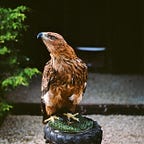Top 5 Winter Films
Looking through the Instagram feeds of accomplished film photographers, it’s easy to fall in love with the look of properly scanned and edited professional negative film.
For those of us who don’t have access to Richard Photo Lab, or who live in parts of the world where the light isn’t quite as warm or consistently golden as Maui or southern California, what choices do we have? The following list puts forward some ideas for films which are more useful for taking photographs in a British winter than a Californian summer. Think more Weston-Super-Mare than Del Mar.
1. Fuji Velvia (50/100)
Due to its narrower exposure latitude, slide film suits the lower intensity light prevalent in the winter months; when the sun does come up in January, it’s at an acute angle, hanging low in the sky, giving direction to shadows. The lighting conditions encountered in winter, with their frequent mixture of sunshine and clouds, make for photographs of great depth. Top tip: meter the scene with an incident light meter to nail your exposure.
2. AGFA precisa CT100
If you can’t stretch to the £10+ asking price for a roll for Fujifilm slide film, you can get excellent results shooting AGFA precisa CT100. I have heard that this film is made for AGFA by Fujifilm. While this is not a claim I can substantiate, based on the results back from the lab, I wouldn’t be surprised if it was true. AGFA Precisa 100CT produces excellent results. Have a look and judge for yourself. Top tip: meter the scene with an incident light meter to nail your exposure.
3. Fujifilm Neopan 400CN
While not a true black and white film, Neopan 400CN has the benefit of increased exposure latitude, and cost and ease of processing; being a C-41 processed film, you can have it processed in an hour down at snappy snaps. Like Fujifilm Pro400H, Neopan 400CN benefits from at least a stop of overexposure.
In the winter time when the colours have drained from the landscape, black and white can produce some incredibly vivid photos where any attempt to use a colour film would look drab by comparison. Top Tip: Meter at iso200 and incident meter for the shadows.
4. Kodak Ektar
If a negative film was made for Autumn, then Ektar with its higher contrast and saturated colours is surely it. Being a film which tends toward the red end of the spectrum, it is perfect for the punchy red, orange and yellow hues of the turning leaves. Ektar is not a first choice film for skin tones (though with the right scanner, it can be made to work with skin tones — see below), but as the name suggests, it mimics the attributes of slide film but with a little more exposure latitude. Don’t expect the latitude of motion picture derived Vision3 Portra films. Ektar gives you saturated colours and higher contrast and depth. As an iso100 film, you’ll be shooting it outdoors with a fast or VR lens. Top Tip: Do not over expose your negative too much unless you want to experience colour shift.
5. Ilford HP5
Photography is painting with light, which means that you’ll need light in order to take a photograph. Modern digital cameras with their hypersensitive sensors are considerably better than film cameras at capturing images in the dark, but there are a few films which still provide something unique for the film photographer. One of these, brought to my attention by Jonathan Canlas is Ilford HP5 which can be pushed 4 stops with excellent results. Yes folks that’s a 400speed film underexposed by 4 stops (shot at iso 6400) and given longer in the chemical soup. You needn’t go this far with HP5, but if you’re shooting MF and the best you have is an f4 lens, you’re gonna need some help. It shows you what is possible.
I took a roll of HP5 to a friend’s wedding which was in a marquee, at night using and the only light available was the internal tent lighting. Have a look at the Instagram for #hp5pushed4stops and #hp5pushed3stops. (Copyright belongs to the original photographer). Top Tip: use a spot meter (or your cameras spot meter) and an 18% grey card to meter your exposures correctly
Bonus Film: Kodak Ektachrome
As digital photography has opened up the marketplace to creatives, more people are looking for ways to differentiate themselves from the digital crowd. As a result, film is having something of a mini resurgence, with demand for film products growing once more.
Having axed Ektachrome from its catalogue in 2012, Kodak announced at CES2017 that it is planning to bring back the colour reversal film in both film format and 135 format for photographers. If this is a hit, they may bring it back in 120. Expected to hit shops around Autumn 2017, it should arrive just in time for the winter.
